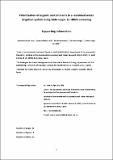Por favor, use este identificador para citar o enlazar a este item:
http://hdl.handle.net/10261/334685COMPARTIR / EXPORTAR:
 SHARE SHARE
 CORE
BASE CORE
BASE
|
|
| Visualizar otros formatos: MARC | Dublin Core | RDF | ORE | MODS | METS | DIDL | DATACITE | |

| Título: | Prioritization of organic contaminants in a reclaimed water irrigation system using wide-scope LC-HRMS screening |
Autor: | García-Vara, Manuel CSIC ORCID; Orlando-Véliz, Dana CSIC ORCID; Bonansea, Rocío Inés CSIC; Postigo, Cristina CSIC ORCID ; López de Alda, Miren CSIC ORCID | Palabras clave: | Water reuse Agriculture Circular economy Contaminants of emerging concern Ecotoxicological risk assessment Micropollutant Non-target screening Water analysis |
Fecha de publicación: | 5-oct-2023 | Editor: | Elsevier | Citación: | Journal of Hazardous Materials 459: 132119 (2023) | Resumen: | A prioritization procedure was developed and implemented at the local level to identify the most relevant organic contaminants of emerging concern (CECs) in an agricultural area irrigated with reclaimed water. A wide-scope screening methodology based on UPLC-HRMS analysis was applied to holistically characterize the CEC footprint in water and its spatial and temporal variations. One hundred and fifty-eight CECs, including pharmaceuticals, industrial chemicals, and pesticides, among others, were identified with a confidence level of 2 in the water samples investigated. After water treatment in the reclamation plant and transport within the irrigation channel network, more than a hundred compounds were still detected at the location where water is abstracted for crop irrigation. Compound ecotoxicity and occurrence (semi-quantified concentrations or peak intensity) were the parameters used to prioritize CECs in the water used for irrigation. Results pointed at venlafaxine, O-desmethyl-venlafaxine, galaxolidone, theophylline/paraxanthine, oxybenzone, and N-phenyl-1-naphtylamine, among others, as CECs of concern in the investigated area. This study provides a simple and cost-effective approach to detecting site-specific priority pollutants that could otherwise be overlooked by national or European regulations. The prioritization tool provided contributes to rationally designing monitoring and attenuation programs and efficiently managing water resources, by ensuring the safety of reclaimed water applications. | Versión del editor: | https://doi.org/10.1016/j.jhazmat.2023.132119 | URI: | http://hdl.handle.net/10261/334685 | DOI: | 10.1016/j.jhazmat.2023.132119 |
| Aparece en las colecciones: | (IDAEA) Artículos |
Ficheros en este ítem:
| Fichero | Descripción | Tamaño | Formato | |
|---|---|---|---|---|
| 1-s2.0-S0304389423014024-main.pdf | Artículo principal | 3,76 MB | Adobe PDF |  Visualizar/Abrir |
| 1-s2.0-S0304389423014024-mmc1.pdf | Material suplementario | 893,14 kB | Adobe PDF |  Visualizar/Abrir |
CORE Recommender
Page view(s)
34
checked on 27-abr-2024
Download(s)
69
checked on 27-abr-2024
Google ScholarTM
Check
Altmetric
Altmetric
NOTA: Los ítems de Digital.CSIC están protegidos por copyright, con todos los derechos reservados, a menos que se indique lo contrario.


